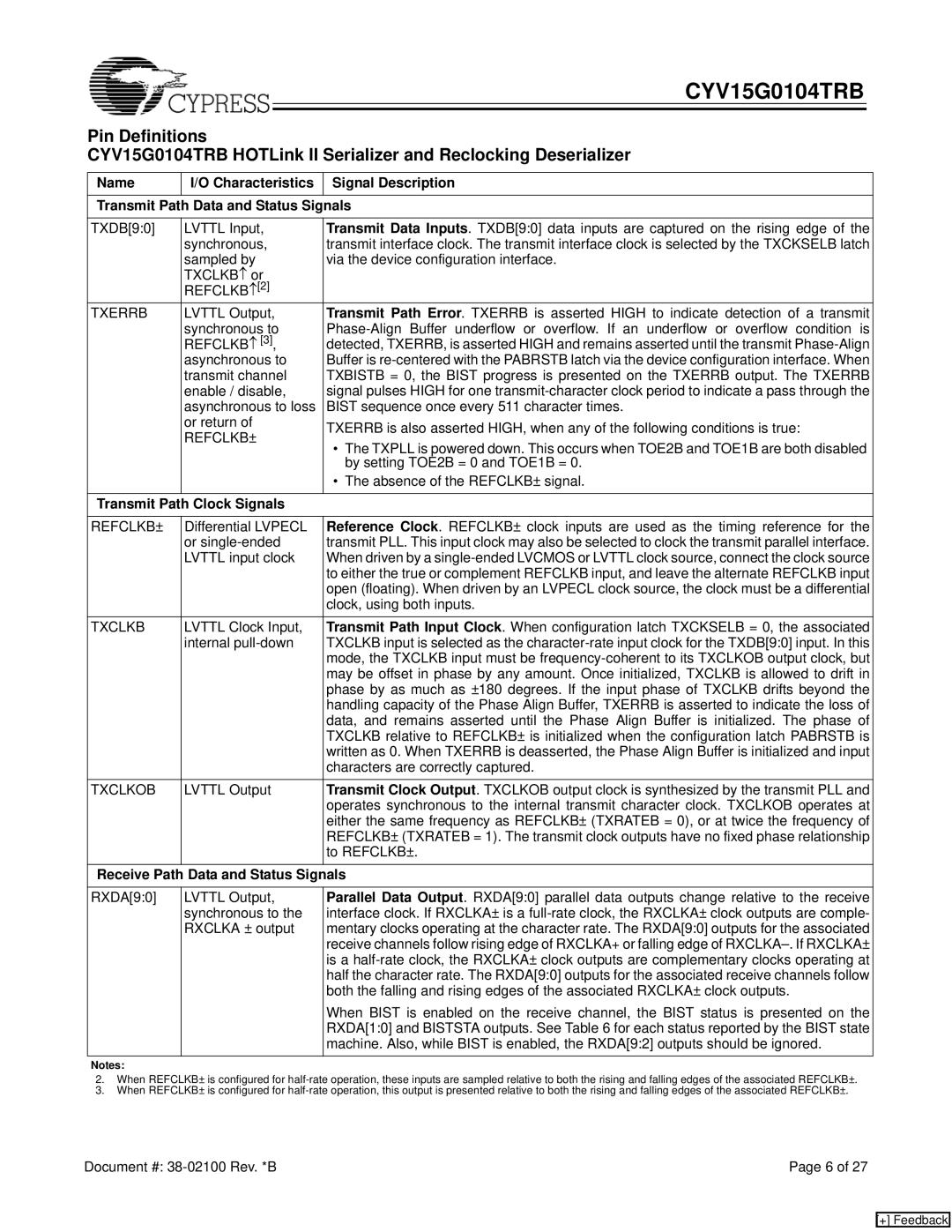
CYV15G0104TRB
Pin Definitions
CYV15G0104TRB HOTLink II Serializer and Reclocking Deserializer
Name | I/O Characteristics | Signal Description |
Transmit Path Data and Status Signals | ||
TXDB[9:0] | LVTTL Input, | Transmit Data Inputs. TXDB[9:0] data inputs are captured on the rising edge of the |
| synchronous, | transmit interface clock. The transmit interface clock is selected by the TXCKSELB latch |
| sampled by | via the device configuration interface. |
| TXCLKB↑ or |
|
| REFCLKB↑[2] |
|
TXERRB | LVTTL Output, | Transmit Path Error. TXERRB is asserted HIGH to indicate detection of a transmit |
| synchronous to | |
| REFCLKB↑ [3], | detected, TXERRB, is asserted HIGH and remains asserted until the transmit |
| asynchronous to | Buffer is |
| transmit channel | TXBISTB = 0, the BIST progress is presented on the TXERRB output. The TXERRB |
| enable / disable, | signal pulses HIGH for one |
| asynchronous to loss | BIST sequence once every 511 character times. |
| or return of | TXERRB is also asserted HIGH, when any of the following conditions is true: |
| REFCLKB± | |
| • The TXPLL is powered down. This occurs when TOE2B and TOE1B are both disabled | |
|
| |
by setting TOE2B = 0 and TOE1B = 0.
• The absence of the REFCLKB± signal.
Transmit Path Clock Signals
REFCLKB± | Differential LVPECL |
| or |
| LVTTL input clock |
TXCLKB | LVTTL Clock Input, |
| internal |
TXCLKOB | LVTTL Output |
Reference Clock. REFCLKB± clock inputs are used as the timing reference for the transmit PLL. This input clock may also be selected to clock the transmit parallel interface. When driven by a
Transmit Path Input Clock. When configuration latch TXCKSELB = 0, the associated TXCLKB input is selected as the
Transmit Clock Output. TXCLKOB output clock is synthesized by the transmit PLL and operates synchronous to the internal transmit character clock. TXCLKOB operates at either the same frequency as REFCLKB± (TXRATEB = 0), or at twice the frequency of REFCLKB± (TXRATEB = 1). The transmit clock outputs have no fixed phase relationship to REFCLKB±.
Receive Path Data and Status Signals
RXDA[9:0] | LVTTL Output, | Parallel Data Output. RXDA[9:0] parallel data outputs change relative to the receive |
| synchronous to the | interface clock. If RXCLKA± is a |
| RXCLKA ± output | mentary clocks operating at the character rate. The RXDA[9:0] outputs for the associated |
|
| receive channels follow rising edge of RXCLKA+ or falling edge of |
|
| is a |
|
| half the character rate. The RXDA[9:0] outputs for the associated receive channels follow |
|
| both the falling and rising edges of the associated RXCLKA± clock outputs. |
|
| When BIST is enabled on the receive channel, the BIST status is presented on the |
|
| RXDA[1:0] and BISTSTA outputs. See Table 6 for each status reported by the BIST state |
|
| machine. Also, while BIST is enabled, the RXDA[9:2] outputs should be ignored. |
Notes:
2.When REFCLKB± is configured for
3.When REFCLKB± is configured for
Document #: | Page 6 of 27 |
[+] Feedback
